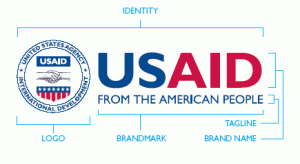 In my journalistic investigations, I’ve given the U.S. Agency for International Development (USAID) a hard time for negligently funding the agribusinesses of drug-trafficking paramilitaries as part of its anti-drug efforts. Right, it’s like “War on Terror” money going to al-Qaida, but for the drug war. Anyway, yesterday, for a new article I’m writing, I was reading the World Bank’s remarkable World Development Report 2011: Conflict, Security & Development. One of the footnotes led me to discover a section USAID’s website all about the agency’s branding. Some of this would have been handy for a paper I wrote last year, hopefully coming out soon in Society and Space, in which I describe USAID “alternative development” projects and specifically mention its billboards as part of the process through which the “concrete-abstraction” of the state becomes manifest in a region of Colombia deemed “stateless.” There’s much to be said about the USAID brand and it has an interesting history (paper idea?). The branding of aid from the U.S. government was invigorated after 9/11 and gained particular traction in the wake of the 2004 Indian Ocean tsunami. USAID says it hopes that its branding efforts will make its graphic identity as recognizable as “McDonald’s and the Golden Arches or Nike and the SWOOSH.”
In my journalistic investigations, I’ve given the U.S. Agency for International Development (USAID) a hard time for negligently funding the agribusinesses of drug-trafficking paramilitaries as part of its anti-drug efforts. Right, it’s like “War on Terror” money going to al-Qaida, but for the drug war. Anyway, yesterday, for a new article I’m writing, I was reading the World Bank’s remarkable World Development Report 2011: Conflict, Security & Development. One of the footnotes led me to discover a section USAID’s website all about the agency’s branding. Some of this would have been handy for a paper I wrote last year, hopefully coming out soon in Society and Space, in which I describe USAID “alternative development” projects and specifically mention its billboards as part of the process through which the “concrete-abstraction” of the state becomes manifest in a region of Colombia deemed “stateless.” There’s much to be said about the USAID brand and it has an interesting history (paper idea?). The branding of aid from the U.S. government was invigorated after 9/11 and gained particular traction in the wake of the 2004 Indian Ocean tsunami. USAID says it hopes that its branding efforts will make its graphic identity as recognizable as “McDonald’s and the Golden Arches or Nike and the SWOOSH.”
 Legislation has required the identification of U.S. aid as such since 1961, but USAID explains that since 9/11 “America’s foreign assistance programs have been more fully integrated into the United States’ National Security Strategy.” As is often noted, security and development—or put another way, violence and economies—have become increasingly conflated. (Not news to anyone who has studied counterinsurgency or the drug war.) Now, “Development” has been explicitly added to “Defense” and “Diplomacy” to become the “third-D” of U.S. foreign policy, brought to you, of course, “from the American People.”
Legislation has required the identification of U.S. aid as such since 1961, but USAID explains that since 9/11 “America’s foreign assistance programs have been more fully integrated into the United States’ National Security Strategy.” As is often noted, security and development—or put another way, violence and economies—have become increasingly conflated. (Not news to anyone who has studied counterinsurgency or the drug war.) Now, “Development” has been explicitly added to “Defense” and “Diplomacy” to become the “third-D” of U.S. foreign policy, brought to you, of course, “from the American People.”
The logo has undergone a long evolution from the Agency’s start in the days of post-War European reconstruction. In 1953, Eleanor Gault from the Marking and Labeling Office of the Mutual Security Agency (one of USAID’s predecessors) designed the enduring clasped hands logo. Since then, the only logo to exclude the clasped-hands is from the early 1990s; it was quickly scrapped as “too radical.” In 2004, USAID says it changed the man-hands so that they became “gender neutral.” The new logo forms part of the entire brand identity, which also includes the brandname and tagline, which “were added to ensure people understand the assistance is provided by U.S. taxpayers.”
“Brand USAID” was publicly rolled out in time for use during U.S. relief efforts in the aftermath of the tsunami in 2004, a year when opinion of the U.S. in Muslim countries were at record lows. “But, in early 2005,” says USAID, “favorability of the U.S. nearly doubled in Indonesia (from 37 to 66 percent) thanks to the massive delivery of – for the first time ‘well branded’ – U.S. foreign assistance.” A Pew Research study makes the more modest estimate of Indonesian favorability toward the U.S. only going from 15 to 38 percent.
The use of the USAID brand identity is highly regulated through its Graphic Standards Manual and has different rules for contractors and those receiving grants and cooperative agreements. Ensuring the USAID stamp is visible on everything from reports and letterhead, to schoolhouses and bags of grains is aimed at promoting the work of the agency as “America’s good-news story,” which is how USAID says it’s been described (only by the agency itself, as far as I could find).
Making USAID projects visible, particularly in conflict areas, is about much more than simple hearts-and-minds propaganda. Sure, they symbolically stake out a space like flags planted in the sand. And, clearly, their support for institution-building and economic development implies a fundamental reorganization of spatial relations. But one thing I’ve been thinking about is how USAID projects help “launder” political and economic relations. In other words, they help make forms of political authority both more powerful and more diffuse; economically, the agribusiness projects funded by USAID in Colombia have been used by paramilitaries for laundering stolen land (“land laundering” is partly the subject of the paper I’m working on). A stronger USAID “brand” might have helped these processes along.
